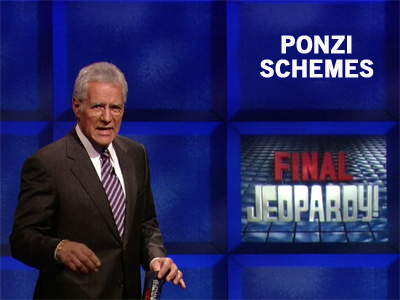Casey: I’ll take Mets Oddities for $400, Alex.
Alex: The answer is Bobby Bonilla and Jason Bay.
Casey: Who are the highest paid outfielders on the 2013 Mets?
Alex: Good job, Casey, and I’m afraid we’re all out of time for this round as we head into Final Jeopardy. The Final Jeopardy category will be “Ponzi Schemes.” Think about your responses while we go to a quick commercial break.

The Title, Introduction and GFX for this post were done by Joe D.
* * * * * * * *
Do you realize the two highest paid Mets outfielders are players no longer with the team?
That’s right; Jason Bay and Bobby Bonilla will make more this year than the Mets’ current outfield of Lucas Duda, Kirk Nieuwenhuis, Mike Baxter, Collin Cowgill and Marlon Byrd.
The Mets made both decisions to get out of bad situations and maintain cost certainty, but in this case it came back to bite them. The first thing a financial advisor tells you is previous success is not a guarantee of future success. The Mets didn’t consider that advice.
Add the $3 million buyout to what the Mets owed Bay (including interest) and it comes to $21 million, paid out in a lump sum and deferred payments over the next several years. The deal also made Bay a free agent and he signed with Seattle. That gave Bay the chance to collect from two teams. Nice deal for him.
The Mets liked the arrangement because the Bay signing was a bust and this freed money for GM Sandy Alderson.
As for Bonilla, the Mets wanted to release him prior to the 2000 season, but didn’t want to eat the $5.9 million on his contract. Instead, the Mets agreed to a 25-year, $29.8 million deferred plan that pays Bonilla nearly $1.2 million annually. Including his pension, income from the Players Association and whatever investments he owns, Bonilla has a great retirement package. Oh, I forgot, there’s also social security.
It turned out to be a horrible deal for the Mets, but at the time they thought they could afford it because they put the original $5.9 million into an investment account with Bernie Madoff, who promised an 18 percent return. The money to pay Bonilla was to come out of that Madoff account and the Mets figured a return of almost $50 million. Being businessmen, they should have realized there can’t be a guaranteed return of any amount, let alone 18 percent.
Naturally, that won’t happen now. What will happen is the Mets remain obligated to write Bonilla a check until 2035. Naturally, hindsight says the Mets should have released Bonilla and taken the salary hit, but hindsight is always 20/20.
Smart moves by Bonilla and Bay, and also Bret Saberhagen, who gets $250,000 annually until 2029. The Mets are also on the hook for $15 million for deferred payments to David Wright.
Then there is the matter of Johan Santana who the Mets will a tidy sum to as well. Since signing his deal in 2008, $5 million of his annual salary has been deferred at 1.25% compound interest. That money is paid every June 30 seven years after the season in which the money was deferred. Those payments begin on 2015 and will last through 2020.
There’s always an element of risk with any long-term contract, but more when part of it is deferred. As it turned out, the Mets outsmarted themselves.













